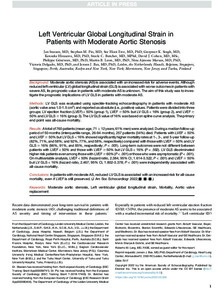Left Ventricular Global Longitudinal Strain in Patients with Moderate Aortic Stenosis
Butcher Steele C; Pio Stephan M; Marsan Nina Ajmone; Généreux Philippe; Hirasawa Kensuke; Singh Gurpreet K; Ewe See Hoi; Bax Jeroen J; Leon Martin B; Cohen David J; Stassen Jan; Delgado Victoria
https://urn.fi/URN:NBN:fi-fe2022081154602
Tiivistelmä
Background
Moderate aortic stenosis (AS) is associated with an increased risk for adverse events. Although reduced left ventricular (LV) global longitudinal strain (GLS) is associated with worse outcomes in patients with severe AS, its prognostic value in patients with moderate AS is unknown. The aim of this study was to investigate the prognostic implications of LV GLS in patients with moderate AS.
Methods
LV GLS was evaluated using speckle-tracking echocardiography in patients with moderate AS (aortic valve area 1.0-1.5 cm2) and reported as absolute (i.e., positive) values. Patients were divided into three groups: LV ejection fraction (LVEF) < 50% (group 1), LVEF ≥ 50% but LV GLS < 16% (group 2), and LVEF ≥ 50% and LV GLS ≥ 16% (group 3). The LV GLS value of 16% was based on spline curve analysis. The primary end point was all-cause mortality.
Results
A total of 760 patients (mean age, 71 ± 12 years; 61% men) were analyzed. During a median follow-up period of 50 months (interquartile range, 26-94 months), 257 patients (34%) died. Patients with LVEF < 50% and LVEF ≥ 50% but LV GLS < 16% showed significantly higher mortality rates at 1-, 3-, and 5-year follow-up (82%, 71%, and 58%; and 92%, 77%, and 58%, respectively) compared with those with LVEF ≥ 50% and LV GLS ≥ 16% (96%, 91%, and 85%, respectively; P < .001). Long-term outcomes were not different between patients with LVEF < 50% and those with LVEF ≥ 50% but LV GLS < 16% (P = .592). LV GLS discriminated higher risk patients even among those with LVEF ≥ 60% (P < .001) or those who were asymptomatic (P < .001). On multivariable analysis, LVEF < 50% (hazard ratio, 2.384; 95% CI, 1.614-3.522; P < .001) and LVEF ≥ 50% but LV GLS < 16% (hazard ratio, 2.467; 95% CI, 1.802-3.378; P < .001) were independently associated with all-cause mortality.
Conclusions
In patients with moderate AS, reduced LV GLS is associated with an increased risk for all-cause mortality, even if LVEF is still preserved.
Kokoelmat
- Rinnakkaistallenteet [19218]
